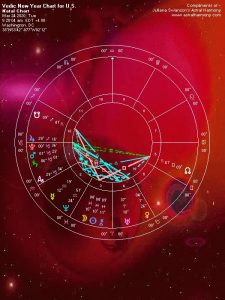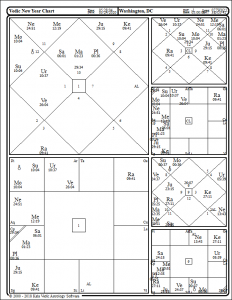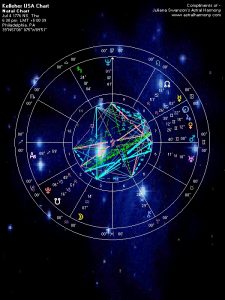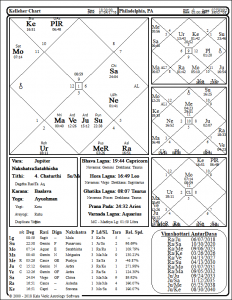One of the many New Year charts used in Vedic astrology is based on the New Moon in Pisces, when the Sun and Moon conjoin in the same celestial longitude (conjunction) in the Pisces constellation. This is known as the culmination of the New Moon in pratipada tithi. (Please note that I am a sidereal astrologer and use the sidereal zodiac exclusively). The New Moon in Pisces is called Chaitra Shukla Pratipada, the first synodic lunar day (tithi) of the waxing Moon (shukla paksha) in the Vedic month of Chaitra (late March to late April).
References in the Brahma Purana and the Chaturvarga Chintamani of Hemadri state that Lord Brahma created the universe on Chaitra Shukla Pratipada. So simply, every year we celebrate the beginning of the Vedic Lunar New Year at the same astrological point that Lord Brahma created the universe! In this current year of 2020, Chaitra Shukla Pratipada tithi falls on March 24 for the U.S., and is set for the capital in Washington D.C., at 5:28:04 AM Eastern Daylight Time (which is 9:28:04 AM UTC). The horoscope for the Vedic New Year for the U.S. is calculated for this place, date, and time.

 Each country will have its own New Year chart based on the different coordinates and time zones. The planets will be in the same signs but will move into other houses. (My friend, astrologer Joni Patry, will be publishing a video about the New Year chart for different locales, so be on the lookout for that on her YouTubechannel.)
Each country will have its own New Year chart based on the different coordinates and time zones. The planets will be in the same signs but will move into other houses. (My friend, astrologer Joni Patry, will be publishing a video about the New Year chart for different locales, so be on the lookout for that on her YouTubechannel.)
The beginning of the Vedic New Year also marks the start of Vasant or Chaitra Navratri, the nine-night spring festival of Mother Divine, when Devi Durga comes down to bless and cleanse the world and all her children at the beginning of the Lunar New Year. It is a very auspicious period and time of positive growth and transformation for Her devotees. Navratri and the Vedic New Year celebrations begin on March 24 in North and South America, and everywhere else in the world on March 25. This is based on the astrological principle that the day of Navratri begins when the pratipada tithi (culmination of the New Moon) is in place before or by sunrise
The samvatsara for this New Year is called Sharvari (Zarvari or Sarvari). A samvatsara is a Sanskrit term for “year.” In the Vedic system, there are 60 samvatsaras. They are described in Brihat Samhita by Sage Varahamahira in “Chapter VIII: Jupiter’s Course (Jovian years).” Each samvatsara carries a particular essence that correlates with its Sanskrit name and also is related to its group ruler.
The samvatsara for 2020-2021 is the fourth in a group of five years ruled by the Manes, who are of two kinds: they are the children of Lord Brahma, known as the Prajapatis, who are great rishis, progenitors, and protectors of the earth, the animal kingdom, and the human race. The Manes are also known as the “Ancestors.” They inhabit their own region between the realms of humans and gods, a place known as Pitriloka. The current five-year cycle ruled by the Manes extends from 2017 to 2022 and is considered to be a challenging period of much calamity. I feel that ancestral propitiation and healing are extremely important during this period as it is ruled by the Ancestors.
Sharvari means “night or twilight,” as well as “pernicious or murderous.” Sage Varahamahira says that this year will bring famine, as we are seeing in parts of Africa already with the worst locust plague in at least 70 years. Additionally, the last Sharvari cycle was in 1960 during the Great Chinese famine from 1959-1961.
 Image above of locusts in East Africa from the Spectator.co.uk
Image above of locusts in East Africa from the Spectator.co.uk
Jataka Parijata says that those born in the Sharvari year will be associated with wealth. This idea may extend generally to this year being a prosperous time, especially related to business and trade. Dhundiraja in Jataka Bharanam associates those born this year with sensuality and pleasure-loving characteristics; with business and trade skills and interests; and engagement in many branches of learning; but also with a tendency toward discordant relationships. We can broadly interpret these qualities to the year 2020-2021, as well.
The last Sharvari year was 60 years ago in 1960, and before that, in 1900. I think of these years as “twilight years” since they represented times of significant world change (and with the name Sharvari meaning “twilight.”). Of course, 1900 was the beginning of the new century, but synchronistically, the U.S. Kelleher birth chart was running the same dasha-bhukti that we will have beginning later in 2020, i.e., the Rahu-Saturn Vimshottari dasha, which will extend from October 30, 2020 to September 6, 2023. The last time this dasha-bhukti occurred was from October 31, 1900 to September 7, 1903.

 During that last Rahu-Saturn period that began in 1900, the U.S. was establishing itself as a dominant world power. The Wild West had been won, oil was king, and the steel industry was booming. The telephone was in use, electricity was being developed in urban areas, and there was much to celebrate amidst the booming economic growth and technological achievements of the period. It was a time of emerging political and social progressivism, as well.
During that last Rahu-Saturn period that began in 1900, the U.S. was establishing itself as a dominant world power. The Wild West had been won, oil was king, and the steel industry was booming. The telephone was in use, electricity was being developed in urban areas, and there was much to celebrate amidst the booming economic growth and technological achievements of the period. It was a time of emerging political and social progressivism, as well.
The year 1960 was also a time of significant cultural change that ushered in a new era and the first rumblings of the truly modern America that we know today. The beginning escalation of the Vietnam War began. The Civil Rights Act of 1960 was established. It was the “Year of Africa” when a series of events took place, mainly the independence of seventeen African nations, highlighting a new Pan-African sentiment on the continent. This was the year when Africa emerged as a major player within the United Nations. JFK was elected, and the space race was just getting started.
In 1960, the Cuban Revolution was in full force when the revolutionary government nationalized all U.S. property in Cuba, leading President Eisenhower to freeze all Cuban assets on American soil, sever diplomatic ties, and tighten its embargo of Cuba. There were Cold War rumblings at this time, and it was just generally the twilight of an old era that was dominated by conventional race, age, and gender stereotypes and roles.
Now as we are beginning this current “twilight year” of 2020, we are experiencing new levels of transformation in areas related to race, age, and gender. There is a great divergence blooming in the realm of political and cultural philosophies, values, goals, and priorities between various strata of society, including between the young and old, just as happened in the revolutionary decade of the 1960s. As in the beginning of the last century and then again in 1960, it feels like we are again heading toward something very different from anything we have known before, including unprecedented new developments in fashion, music, and the arts.
In this case, we are also facing the imminent awakening of Artificial Intelligence, along with other new medical and technological advancements, and we are also facing many new natural and human-made threats. We are on the verge of a huge wealth and power transfer from the Baby Boomers to the younger generations. The U.S. is still embroiled in conflicts and uncertainties abroad despite the will of some of the people and the attempts of the current administration to move away from the globalist agenda. It’s truly an exciting and at times unnerving time to be alive!
On or around the first day of the Vedic Lunar New Year, the new calendar (panchanga) is often installed in a Hindu temple ceremony in which the year’s upcoming predictions are read aloud. These are based on the astrological chart calculated for the New Moon in Pisces. This is done for a particular country, usually India where this system originated, but the forecast is often given more generally for the world at large.
In calculating a Vedic New Year chart, there are a few considerations to keep in mind. First, the pratipada tithi (when the Sun-Moon are in an exact conjunction in Pisces) must be in place by or before sunrise. Second, the planetary ruler of the day (vara lord) becomes the year lord. Third, a day extends from sunrise to sunrise. The Moon is the day lord and thus the year lord of the 2020-2021 U.S. New Year chart. This is because March 24 is the first day that pratipada tithi is in place at sunrise, and because the day is still considered to be a Monday (ruled by the Moon) as the New Moon culminates before sunrise (Monday), even though in civil calendars it is considered to be Tuesday any time after midnight.
It is important to note that the Moon, because it’s the year lord, is more important than usual this year in this chart. The Moon, representing the public, is afflicted by an aspect from Saturn and a t-square with the lunar nodes, suggesting a year of upheaval, turmoil, and uncertainty among the populace. A great deal of negativity will be spouted about in the news and social media (as usual), and there is a clear need to heal the chronic malaise, anger, and pessimism so rampant within our collective consciousness.
This same theme is echoed in the other New Year forecasts I have written about previously. I see this also indicated by the conjunction of the planet-comet Chiron (the Wounded Healer archetype) in conjunction with the Sun and Moon. This suggests a great need and opportunity for healing in the mass mind, which starts within each of us who are an integral part of the whole.
The Moon and Sun with Chiron in the 3rd house (respiratory illness) in a t-square with the lunar nodes and with the aspect from Saturn also points to the novel coronavirus outbreak from China which has also hit many other countries including the U.S. Based on my extensive astrological analysis about the outbreak going back to early January, I doubt that this outbreak will kill significant numbers of the population as we have seen in the most serious pandemics in history.
Yes, it induces a lot of fear and even hysteria, and has already had a significant effect on travel (third house matters), and has taken a toll on businesses, schools, and the work force in certain countries due to illness and quarantine. Yet, the mortality rate remains relatively low, and the threat to the general public in the U.S. is considered to be minimal, while the true danger is mostly limited to elderly and already medically fragile individuals, as well as health care workers and first responders, which of course is a very sad and worrisome matter.
The lagna or rising sign (ascendant) is Dhanistha nakshatra at 29+ degrees of Capricorn. Dhanistha being ruled by both Saturn and Mars brings a dynamic similar to Agni-Maruti Yoga (as in a Mars-Saturn conjunction), which can play out in willfulness, impatience, anger, negative attitudes, resentments, violence, and sudden explosive events. On a positive note, certain stubborn, deep-rooted problems that have been around a long time will be coming out in the open more and more to be addressed and (one hopes) to be resolved.
The 29th degree is called anaretic, that which destroys form, another indication for a lot of changes ahead this year. It is known as a “karmic degree of expiation” that brings a conclusion, and matters that have not been addressed or dealt with in the previous cycles will have to come up and be dealt with through some significant collective events. Fortunately, the first house has a Shubha Kartari Yoga in which benefics Jupiter and Mercury are hemming from the houses on either side, which brings an element of grace and protection to whatever big changes are afoot.
I noted that the 29-degree Capricorn ascendant has not occurred in any Vedic New Year charts for the U.S. going back hundreds of years. However, I did find this same ascendant in two previous mundane horoscopes, which may be read as an astrological portent of something similar that may be experienced this year. The first is the chart for the August 1968 Democratic Convention in Chicago, with a 28+ Capricorn ascendant which we round up to 29.
During the convention, tens of thousands of protesters and rioters swarmed the streets to rally against the Vietnam War and the socio-political status quo. The convention was held during a year of civil unrest, violence, and political upheaval during the Vietnam War era and following the assassinations of Martin Luther King in April, and Robert F. Kennedy in June (as Kennedy had been running for the Democratic nomination when he was killed). We may see similar polarizing cultural and political turmoil this year as well, in the months leading up to the Democratic Convention.
 The second event was the Granville Train Disaster in January 1977 which occurred at Granville, New South Wales, a western suburb of Sydney, when a crowded commuter train derailed, running into the supports of a road bridge that collapsed onto two of the train’s passenger carriages. It remains the worst rail disaster in Australian history and the greatest loss of life in a confined area post-war. Let’s pray that nothing like this ever happens again, at any time including in the new Vedic Lunar New Year ahead.
The second event was the Granville Train Disaster in January 1977 which occurred at Granville, New South Wales, a western suburb of Sydney, when a crowded commuter train derailed, running into the supports of a road bridge that collapsed onto two of the train’s passenger carriages. It remains the worst rail disaster in Australian history and the greatest loss of life in a confined area post-war. Let’s pray that nothing like this ever happens again, at any time including in the new Vedic Lunar New Year ahead.
 Everything happening in the world this year, for either “good or bad,” will be super-intensified by what’s known as a Kala Sarpa Yoga (Serpent of Time Combination), in which the ascendant and all the planets (inner and outer planets) lie between the axis of the lunar nodes Rahu and Ketu, and on one side of the sky mirror (chart). I looked back and did not see a Kala Sarpa in any other Vedic New Year charts over the past 100 years. Keep in mind that the Kala Sarpa is affecting the whole world as it will appear in every country’s Vedic New Year chart.
Everything happening in the world this year, for either “good or bad,” will be super-intensified by what’s known as a Kala Sarpa Yoga (Serpent of Time Combination), in which the ascendant and all the planets (inner and outer planets) lie between the axis of the lunar nodes Rahu and Ketu, and on one side of the sky mirror (chart). I looked back and did not see a Kala Sarpa in any other Vedic New Year charts over the past 100 years. Keep in mind that the Kala Sarpa is affecting the whole world as it will appear in every country’s Vedic New Year chart.
 In Vedic astrology, Kala Sarpa is known as a dosha (fault or defect); and, in mundane (world) astrology, Kala Sarpa can be associated with catastrophic events or setbacks, reversals, and danger or harm to certain rulers or countries. This can point to all kinds of extreme energies and events, including wild and unbelievable conspiracies or conspiracy theories; riots and revolutions; but also groundbreaking original, and innovative discoveries. The overarching effect of Kala Sarpa can be dramatic, passionate, obsessive, or polarizing.
In Vedic astrology, Kala Sarpa is known as a dosha (fault or defect); and, in mundane (world) astrology, Kala Sarpa can be associated with catastrophic events or setbacks, reversals, and danger or harm to certain rulers or countries. This can point to all kinds of extreme energies and events, including wild and unbelievable conspiracies or conspiracy theories; riots and revolutions; but also groundbreaking original, and innovative discoveries. The overarching effect of Kala Sarpa can be dramatic, passionate, obsessive, or polarizing.
A very rare conjunction is in place including Pluto, Saturn, and Mars in Capricorn, and with Jupiter in an “out of sign” conjunction at the 29-degree edge between Sagittarius and Capricorn. This is called a stellium and is quite significant in that it has an intense quality. I am reading the conjunction as being in the 12th house since all the planets are behind the ascendant at a significant distance. With the stellium also conjoined Ketu, this may suggest some kind of unique cultural or spiritual awakening. I would refer you back to my previous article for more details about this conjunction.
The last time a conjunction occured with Mars, Saturn, Jupiter, and Pluto in Capricorn was during a time of prosperity and renaissance from 1000 to 1300 BCE. In my opinion, this has a positive connotation for the coming Vedic New Year. The 12th house energy of this combination indicates it could be a great year for all of us to become more involved in spiritual or charitable service in the world.
The 12th house also relates to international matters and also health matters, and with Ketu here especially, international travel conditions are upside down right now as we begin the Vedic New Year. Additionally, other nations are under duress, and hospitals and medical care systems everywhere are being stressed due to the novel coronavirus and Covid-19 disease concerns.
The intense 12th house energy also focuses on themes of ending, loss, worry, hidden enemies, and mysterious matters (that which may be hidden from us), and may suggest a great deal of dissatisfaction, confusion, paranoia, and angst in the mass mind. But all of this intense upheaval may also have some very positive outcomes too, in the end, as Jupiter is in the 29th degree of mastery in a trine with Venus in the 4th house.
Rahu in Gemini in the 6th house points to the current health epidemic and also the ongoing debt crisis in America. It also points to some impending turmoil and crisis involving the work force (unemployment issues arising), which may not fully abate until Rahu leaves Gemini in late September. Mercury as the 6th house ruler in the 2nd house suggests that certain medical and defense industry investments and profits may be on the rise. Mercury is also the 9th house ruler, and as it is placed in the 2nd house and unafflicted, there is some element of protection and good fortune in terms of the overall economy, and possibly we will see some progress and gain in the second half of the year through trade and commerce.
The fixed stars Antares and Aldebaran are very prominent in the New Year chart, as Antares (15 degrees, 54 minutes of sidereal Scorpio) is conjoined the MC medium coeli/midheaven (known as madhya lagna in Vedic astrology); and, Aldebaran (15 degrees, 55 minutes of sidereal Taurus) is conjoined the IC/imum coeli (known as patala lagna in Vedic astrology). In mundane astrology, the MC relates to the government, especially the President and his administrative branch; and it also symbolizes planning and strategy, forward momentum, and accomplishment. The IC represents the homeland and important events within the homeland, and also relates to weather and seismic events, and real estate/agriculture/property matters.
Antares is a flaming red binary star in the heart of the Scorpius constellation. It is 883 times the size of our Sun. As the fifteenth brightest star in the sky, it indicates passion, pride, strength, strategic success, and sometimes, revenge. To have it conjoined the MC in the New Year chart is quite fortunate. Antares is also the abode of Archangel Uriel (Oriel), Angel of Light, Wisdom, and Peace, who is beaming blessings down on us this year.
Aldebaran, the thirteenth brightest star in the sky, is located in the eye of Taurus the Bull and is known as the Eye of God, Eye of Illumination, and Eye of Revelation. Aldebaran is the abode of Archangel Michael, the greatest warrior angel who is “Like God” and avenges and protects against evil. Aldebaran in its lower manifestation can represent the danger of violence and sickness. It can ultimately be favorable for business and domestic matters, but it does also reflect the current pandemic and financial crisis. This placement can also be an indicator for catastrophic weather and/or seismic events this year.
The U.S. Kelleher chart is in the Rahu-Jupiter period of the Vimshottari dasha from June 7, 2018 until October 30. 2020. This is an intense “stormy” period for a few reasons. Rahu is in the toxic Ashlesha nakshatra in the 8th house of troubles and upheaval, and Jupiter is in the tempestuous Ardra nakshatra in the 7th house, and they are in a 2/12 semi-sextile relationship which signifies societal and political volatility and conflict. In the tara chakra (tara bala nakshatra relationship scheme), Ashlesha nakshatra is in a good relationship with Shatabisha nakshatra, the Moon’s nakshatra, and this may be good for overall prosperity in the 18-year Rahu dasha. However, the nakshatra of sub-lord Jupiter (Ardra) is in a difficult tara bala relationship with Shatabisha, indicating some uncertain, destabilizing, and dangerous times during this period.
The nation may see certain kinds of progress and improvement in the Rahu-Saturn period from October 30, 2020 to September 6, 2023. This is for a few reasons. First, according to the tara bala relationship scheme, Chitra nakshatra, where Saturn resides, is in a very friendly and harmonious relationship with both Shatabisha nakshatra, where the Moon resides, and with Ashlesha nakshatra, which the mahadasha lord Rahu occupies. Additionally, Rahu and Saturn are in a 3/11 sextile aspect, which could possibly indicate a period of increased diplomacy and cooperation between warring factions in the nation as a whole. Further, this period may bring the nation together through a realignment with certain cherished values and traditions. It should also be a good period for relationships with our neighbors.
I am not a “financial astrologer” and actually do not know of any astrologers who are able to consistently and specifically forecast financial and economic trends. Some astrologers are predicting a long-term financial downturn or recession in the Rahu-Saturn period. Others are predicting a recession due to the conjunction of Saturn and Jupiter in sidereal Capricorn in 2020-2021. However, the last time that Saturn and Jupiter conjoined in Capricorn was in 1961-1962, exactly at the end of a recession, not the beginning of one.
Last December, I predicted that there was a possibility of a stock market crash beginning in late February, which of course did happen. This was based on transits to the U.S. Kelleher chart, but I also wonder if this was related to the Rahu-Jupiter-Moon dasha in place from February 18 to May 1, 2020, as the Moon rules the 8th house of loss and turmoil, and is placed in the 3rd house of public sentiment. It is a well known fact that the public’s fear about the novel coronavirus was the main trigger for this recent financial market downturn.
May the winds, the oceans, the herbs, and night and days, the mother earth, the father heaven, all vegetation, the sun, be all sweet to us…Let us follow the path of goodness for all times, like the sun and the moon moving eternally in the sky…Let us be charitable to one another…Let us not kill or be violent with one another…Let us know and appreciate the points of view of others…And let us unite.


